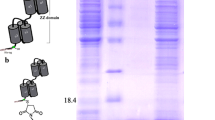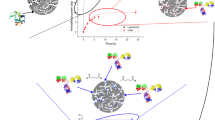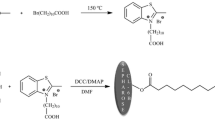Abstract
Affinity chromatography is one of the most common techniques employed at the industrial-scale for antibody purification. In particular, the purification of human immunoglobulin G (hIgG) has gained relevance with the immobilization of its natural binding counterpart—Staphylococcus aureus Protein A (SpA) or with the recent development of biomimetic affinity ligands, namely triazine-based ligands. These ligands have been developed in order to overcome economic and leaching issues associated to SpA. The most recent triazine-based ligand—TPN-BM, came up as an analogue of 2-(3-amino-phenol)-6-(4-amino-1-naphthol)-4-chloro-sym-triazine ligand also known as ligand 22/8 with improved physico-chemical properties and a greener synthetic route. This work intends to evaluate the potential of TPN-BM as an alternative affinity ligand towards antibody recognition and binding, namely IgG, at an atomic level, since it has already been tested, after immobilization onto chitosan-based monoliths and demonstrated interesting affinity behaviour for this purpose. Herein, combining automated molecular docking and molecular dynamics simulations it was predicted that TPN-BM has high propensity to bind IgG through the same binding site found in the crystallographic structure of SpA_IgG complex, as well as theoretically predicted for ligand 22/8_IgG complex. Furthermore, it was found that TPN-BM established preferential interactions with aromatic residues at the Fab domain (Trp 50, Tyr 53, Tyr 98 and Trp 100), while in the Fc domain the main interactions are based on hydrogen bonds with pH sensitive residues at operational regime for binding and elution like histidines (His 460, His 464, His 466). Moreover, the pH dependence of TPN-BM_IgG complex formation was more evident for the Fc domain, where at pH 3 the protonation state and consequently the charge alteration of histidine residues located at the IgG binding site induced ligand detachment which explains the optimal elution condition at this pH observed experimentally.





Similar content being viewed by others
References
Elvin JG, Couston RG, van der Walle CF (2013) Therapeutic antibodies: market considerations, disease targets and bioprocessing. Int J Pharm 440:83–98. doi:10.1016/j.ijpharm.2011.12.039
Hübner K, Sahle S, Kummer U (2011) Applications and trends in systems biology in biochemistry. FEBS 278:2767–2857. doi:10.1111/j.1742-4658.2011.08217.x
Gill DS, Damle NK (2006) Biopharmaceutical drug discovery using novel protein scaffolds. Curr Opin Biotech 17:653–658. doi:10.1016/j.copbio.2006.10.003
Ayyar BV, Arora S, Murphy C, O’Kennedy R (2012) Affinity chromatography as a tool for antibody purification. Methods 56:116–129. doi:10.1016/j.ymeth.2011.10.007
Roque ACA, Silva CSO, Taipa MA (2007) Affinity-based methodologies and ligands for antibody purification: advances and perspectives. J Chromatogr A 1160:44–55. doi:10.1016/j.chroma.2007.05.109
Teng SF, Sproule K, Husain A, Lowe CR (2000) Affinity chromatography on immobilized “biomimetic” ligands synthesis, immobilization and chromatographic assessment of an immunoglobulin G-binding ligand. J Chromatogr B 740:1–15
Batalha IL, Hussain A, Roque ACA (2010) Gum Arabic coated magnetic nanoparticles with affinity ligands specific for antibodies. J Mol Recognit 23:462–471. doi:10.1002/jmr.1013
Barroso T, Temtem M, Hussain A et al (2010) Preparation and characterization of a cellulose affinity membrane for human immunoglobulin G (IgG) purification. J Memb Sci 348:224–230
Barroso T, Roque ACA, Aguiar-Ricardo A (2012) Bioinspired and sustainable chitosan-based monoliths for antibody capture and release. RSC Adv 2:11285–11294. doi:10.1039/c2ra21687f
Branco RJF, Dias AMGC, Roque ACA (2012) Understanding the molecular recognition between antibody fragments and Protein A biomimetic ligand. J Chromatogr A 1244:106–115. doi:10.1016/j.chroma.2012.04.071
Huang B, Liu F-F, Dong X-Y, Sun Y (2012) Molecular mechanism of the effects of salt and pH on the affinity between protein A and human immunoglobulin G1 revealed by molecular simulations. J Phys Chem B 116:424–433. doi:10.1021/jp205770p
Huang B, Liu F-F, Dong X-Y, Sun Y (2011) Molecular mechanism of the affinity interactions between protein A and human immunoglobulin G1 revealed by molecular simulations. J Phys Chem B 115:4168–4176. doi:10.1021/jp111216g
Barroso T, Lourenço A, Araújo M et al (2013) A green approach toward antibody purification: a sustainable biomimetic ligand for direct immobilization on (bio)polymeric supports. J Mol Recognit 26:662–671. doi:10.1002/jmr.2309
Sheldon RA (2012) Fundamentals of green chemistry: efficiency in reaction design. Chem Soc Rev 41:1437–1451. doi:10.1039/c1cs15219j
Dunn PJ (2012) The importance of green chemistry in process research and development. Chem Soc Rev 41:1452–1461. doi:10.1039/c1cs15041c
Salvalaglio M, Zamolo L, Busini V (2009) Molecular modeling of Protein A affinity chromatography. J Chromatogr A 1216:8678–8686
Saphire EO, Parren PW, Pantophlet R et al (2001) Crystal structure of a neutralizing human IGG against HIV-1: a template for vaccine design. Science 293:1155–1159. doi:10.1126/science.1061692
Morris G, Goodsell D (1998) Automated docking using a Lamarckian genetic algorithm and an empirical binding free energy function. J Comput Chem 19:1639–1662
Mehler EL, Solmajer T (1991) Electrostatic effects in proteins: comparison of dielectric and charge models. Protein Eng 4:903–910
Zamolo L, Busini V, Moiani D (2008) Molecular dynamic investigation of the interaction of supported affinity ligands with monoclonal antibodies. BiotechnolProgr 24:527–539
Hess B, Kutzner C (2008) GROMACS 4: algorithms for highly efficient, load-balanced, and scalable molecular simulation. J Chem Theor Comput 4:435–447
Schüttelkopf AW, Van Aalten DMF (2004) PRODRG: a tool for high-throughput crystallography of protein-ligand complexes. Acta Crystallogr D 60:1355–1363
Oostenbrink C, Villa A, Mark AE, van Gunsteren WF (2004) A biomolecular force field based on the free enthalpy of hydration and solvation: the GROMOS force-field parameter sets 53A5 and 53A6. J Comput Chem 25:1656–1676. doi:10.1002/jcc.20090
Berendsen HJC, Postma JPM, van Gunsteren WF et al (1984) Molecular dynamics with coupling to an external bath. J Chem Phys 81:3684–3690. doi:10.1063/1.448118
Bussi G, Donadio D, Parrinello M (2007) Canonical sampling through velocity rescaling. J Chem Phys 126:014101–014107. doi:10.1063/1.2408420
Hess B, Bekker H, Berendsen HJC, Fraaije JGEM (1997) LINCS: a linear constraint solver for molecular simulations. J Comput Chem 18:1463–1472. doi:10.1002/(SICI)1096-987X(199709)18:12<1463:AID-JCC4>3.0.CO;2-H
DeLano WL (2002) DeLano Scientific LLC, San Carlos, CA
Humphrey W, Dalke A, Schulten K (1996) VMD: visual molecular dynamics. J Mol Graph 14:33–38
Huey R, Morris G (2007) A semiempirical free energy force field with charge-based desolvation. J Comput Chem 28:1145–1152. doi:10.1002/jcc
Morris G, Huey R (2009) AutoDock4 and AutoDockTools4: automated docking with selective receptor flexibility. J Comput Chem 30:2785–2791. doi:10.1002/jcc
Winzor D (2001) Quantitative affinity chromatography. J Biochem Bioph Meth 49:99–121
Acknowledgments
The authors would like to thank the financial support from Fundação para a Ciência e a Tecnologia (FCT) through contracts PEst-C/EQB/LA0006/2011, MIT-Pt/BS-CTRM/0051/2008, PTDC/EBB-BIO/102163/2008, PTDC/EBB-BIO/098961/2008 and PTDC/EBB-BIO/118317/2010 and doctoral grants SFRH/BD/62475/2009 (T. B.) and SFRH/BPD/69163/2010 (R. B.), Fundação Calouste Gulbenkian, FEDER.
Author information
Authors and Affiliations
Corresponding authors
Electronic supplementary material
Below is the link to the electronic supplementary material.
Rights and permissions
About this article
Cite this article
Barroso, T., Branco, R.J.F., Aguiar-Ricardo, A. et al. Structural evaluation of an alternative Protein A biomimetic ligand for antibody purification. J Comput Aided Mol Des 28, 25–34 (2014). https://doi.org/10.1007/s10822-013-9703-1
Received:
Accepted:
Published:
Issue Date:
DOI: https://doi.org/10.1007/s10822-013-9703-1




